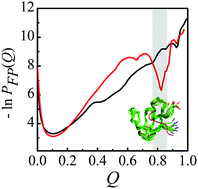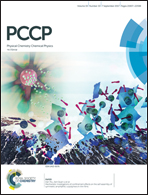The low populated folding intermediate of a mutant of the Fyn SH3 domain identified by a simple model†
Abstract
Experimental studies indicate that the A39V/N53P/V55L Fyn SH3 domain folds from the unfolded state to the native state via a low-populated on-pathway intermediate, whereas the folding of the wildtype is two-state-like. To get insights into the biophysical basis of their different folding mechanisms, we used native-centric models with and without additional transferrable, sequence-dependent nonnative hydrophobic interactions to study the folding behaviors of the Fyn SH3 domain and its mutant. The pure native-centric model predicts that both the wildtype and the mutant fold in a two-state manner, without any detectable intermediate. However, in the simulated trajectories based on the model with sequence-dependent nonnative hydrophobic interactions, a low populated on-pathway intermediate was identified for the mutant, but not for the wild type, although it is not sufficient to induce chevron rollover. In the modelling intermediate, the topology of strands β1 to β4 followed by the helix turn is native-like, while strand β5 is mostly unstructured, which is in good agreement with experiments. Meanwhile, the nonnative contacts in the intermediate overlapped largely with those identified experimentally. Further investigation implies that different folding mechanisms between the wildtype and the mutant might arise from the distinction of the nonnative contact patterns at the transition states. In addition, we predicted that nonnative interactions led to deceleration or acceleration of the folding largely depending on whether they could destabilize or stabilize the transition state relative to the unfolded state. This study implies that the simple native-centric model augmented by sequence-dependent nonnative hydrophobic interactions should be useful in general to predict the folding of proteins with a low-populated intermediate.



 Please wait while we load your content...
Please wait while we load your content...